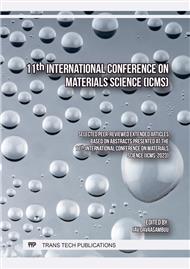[1]
D Kai, M J Tan, P L Chee, et al. Towards lignin-based functional materials in a sustai Green Chemistry, 2016, 18(5): 1175-1200
Google Scholar
[2]
W.J Liu, H Jiang, H Q Yu. Thermochemical conversion of lignin to functional materials: a review and future directions[J]. Green Chemistry, 2015, 17(11): 4888-490
DOI: 10.1039/c5gc01054c
Google Scholar
[3]
H.G Chae, Y.H Choi, M.L Minus, et al. Carbon nanotube reinforced small diameter polyacrylonitrile based carbon fiber[J]. Composites Science and Technology, 2009, 69(3-4): 406-4
DOI: 10.1016/j.compscitech.2008.11.008
Google Scholar
[4]
S Gao, Y Chen, H Fan, et al. Large scale production of biomass-derived N-doped porous carbon spheres for oxygen reduction and supercapacitors[J]. Journal of Materials Chemistry A, 2014, 2(10): 3317-3324.
DOI: 10.1039/c3ta14281g
Google Scholar
[5]
J Serafin, M Ouzzine, O F Cruz, et al. Conversion of fruit waste-derived biomass to highly microporous activated carbon for enhanced CO2 capture[J]. Waste Management, 2021, 136:273-282.
DOI: 10.1016/j.wasman.2021.10.025
Google Scholar
[6]
H Cui, J Xu, J Shi, et al. Evaluation of different potassium salts as activators for hierarchically porous carbons and their applications in CO2 adsorption[J]. Journal of Colloid and Interface Science, 2021, 583: 40-49.
DOI: 10.1016/j.jcis.2020.09.022
Google Scholar
[7]
T.Q Lin, I.W Chen, F.X Liu, et al. Nitrogen-doped mesoporous carbon of extraordinary capacitance for electrochemical energy storage[J]. Science, 2015, 350(6267): 1508-1513.
DOI: 10.1126/science.aab3798
Google Scholar
[8]
fibers by various mineral acids[J]. ASEAN Journal on Science and Technology for Development, 2004, 21(1): 57-67.
Google Scholar
[9]
Y Qin, D Yang, F Gu, et al. Biorefinery lignosulfonates as a dispersant for coal water slurry[J]. Sustainable Chemical Processes, 2016, 4: 1-8.
DOI: 10.1186/s40508-016-0050-0
Google Scholar
[10]
J Song, W Shen, J Wang, et al. Superior carbon-based CO2 adsorbents prepared from poplar anthers[J]. Carbon, 2014, 69: 255-263.
DOI: 10.1016/j.carbon.2013.12.024
Google Scholar
[11]
C Goel, H Bhunia, P K Bajpai. Resorcinol-formaldehyde based nanostructured carbons for CO2 adsorption: kinetics, isotherm and thermodynamic studies[J]. RSC advances, 2015, 5(113): 93563-93578.
DOI: 10.1039/c5ra16255f
Google Scholar
[12]
G Yin, Z Liu, Q Liu, et al. The role of different properties of activated carbon in CO2 adsorption[J]. Chemical Engineering Journal, 2013, 230: 133-140.
DOI: 10.1016/j.cej.2013.06.085
Google Scholar
[13]
F Gu, J Geng, M Li, et al. Synthesis of chitosan–ignosulfonate composite as an adsorbent for dyes and metal ions removal from wastewater[J]. ACS omega, 2019, 4(25): 21421-21430.
DOI: 10.1021/acsomega.9b03128
Google Scholar
[14]
B Ashourirad, P Arab, T Islamoglu, et al. A cost-effective synthesis of heteroatom-doped porous carbons as efficient CO2 sorbents[J]. Journal of Materials Chemistry A, 2016, 4(38): 14693-14702.
DOI: 10.1039/c6ta06251b
Google Scholar
[15]
A Rehman, S J Park. Environmental remediation by microporous carbon: an efficient contender for CO2 and methylene blue adsorption[J]. Journal of CO2 Utilization, 2019, 34: 656-667.
DOI: 10.1016/j.jcou.2019.08.015
Google Scholar
[16]
Y D Chen, F Liu, N Q Ren, et al. Revolutions in algal biochar for different applications: State-of-the-art techniques and future scenarios[J]. Chinese Chemical Letters, 2020, 31(10): 2591-2602.
DOI: 10.1016/j.cclet.2020.08.019
Google Scholar
[17]
D Wu, Y Yang, J Liu, et al. Plasma-modified N/O-doped porous carbon for CO2 capture: an experimental and theoretical study[J]. Energy & Fuels, 2020, 34(5): 6077-6084.
DOI: 10.1021/acs.energyfuels.0c00415
Google Scholar
[18]
M Sevilla, J B Parra, A B Fuertes. Assessment of the role of micropore size and N-doping in CO2 capture by porous carbons[J]. ACS applied materials & interfaces, 2013, 5(13): 6360-6368.
DOI: 10.1021/am401423b
Google Scholar
[19]
R Kishor, A K Ghoshal. Polyethylenimine functionalized as-synthesized KIT-6 adsorbent for highly CO2/N2 selective separation[J]. Energy & Fuels, 2016, 30(11): 9635-9644.
DOI: 10.1021/acs.energyfuels.6b02082
Google Scholar
[20]
X Zhang, J Wu, H Yang, et al. Preparation of nitrogen-doped microporous modified biochar by high temperature CO2–NH3 treatment for CO2 adsorption: effects of temperature[J]. Rsc Advances, 2016, 6(100): 98157-98166.
DOI: 10.1039/c6ra23748g
Google Scholar
[21]
X Ma, L Li, Z Zeng, et al. Experimental and theoretical demonstration of the relative effects of O-doping and N-doping in porous carbons for CO2 capture[J]. Applied Surface Science, 2019, 481: 1139-1147.
DOI: 10.1016/j.apsusc.2019.03.162
Google Scholar
[22]
Y Wang, M Wang, Z Wang, et al. Tunable-quaternary (N, S, O, P)-doped porous carbon microspheres with ultramicropores for CO2 capture[J]. Applied Surface Science, 2020, 507: 145130-145139.
DOI: 10.1016/j.apsusc.2019.145130
Google Scholar



